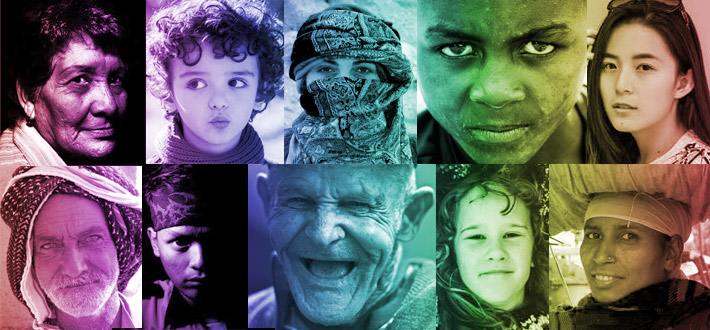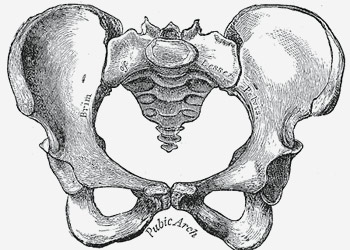What Is The Core Commonality In How We Learn About The Minds Of Humans And Other Animals?

Human Universals: Traits All Humans Share
Human evolution has produced a remarkable set of common characteristics, which is what makes united states human. Some are physical, like the skeleton for walking upright, a vocal tract for speech communication, and dexterity for tool use. We share a mutual set of emotions and the capacity for self-awareness, abstract thinking, knowing correct from wrong, and doing complicated math. All are examples of the hundreds of traits shared by all human beings in the world today.
The process of homo adaptation is the simultaneous development of all the following distinctly human characteristics, in a positive feedback loop. The furnishings of the loop have continuously increased the deviation between our nearest ancestors and united states of america.
Bipedalism: Standing Up and Walking

Bipedal Lucy dates from about three.75 million years ago.
Human beings are bipedal—that is, we walk on two feet instead of on all fours. Chimps and gorillas can stand upright at times, simply when they move they typically practice so on all fours. A fossil skeleton chosen Lucy is the earliest ancestor establish to appointment whose bones show that she walked on two legs. Lucy is about 3.75 million years old, most 1 million years older than the use of tools.
Bipedal walking and running enabled united states to cover greater distances over time than whatever other animal. About all other animals live their lives in the environs in which they are born. Our ancestors more readily travelled into unexplored territories and thus triggered several adaptive advantages for us over other animals:
A standing creature tin can see farther than it can odour, so a more sophisticated visual system needed to develop along with our upright posture. Our ancestors thus were able to spot approaching danger as well equally opportunities from farther abroad.
Hands were freed from weight-bearing responsibilities, making tool employ possible.
Erect posture also led to profound changes in human sexuality and in our social systems.
Immaturity and its Consequences

Female human pelvis bone.
With the freeing of the front limbs, the hind limbs had to adapt to bearing the entire weight of the body. The human back was non originally "designed" to support an upright posture (which partially explains why dorsum pains are a common complaint). To support the additional weight, the human pelvis grew thicker than that of the great apes, which fabricated the female'southward birth canal, the opening through which infants are born, much smaller.
While the birth canal was becoming smaller, however, the fetus'due south brain and head were growing larger. If there had been no evolutionary correction for this, the man species would take died out; the solution was to have human babies built-in very early in their evolution.
Human children accept the longest infancy in the animal kingdom. They are not every bit competent and independent as baby chimps or baboons. Within a day, baby baboons can concord onto their mothers past themselves. The human child is helpless and will dice if not cared for during the first few years of its life.
At birth a chimp'due south brain is well-nigh 45 percent of its adult weight, while a homo baby's brain is 25 per centum of its adult weight. This means that the major portion of the human being brain's development occurs exterior the womb, and the environment plays a much greater role in it than in any other beast's brain development. Because the environment we are borne into differs for each person, the specific abilities that each of us develops differ considerably.
The Female parent-Father-Infant Relationship
A helpless babe requires at least i caregiving parent to survive. In other species, a newborn tin can fend for itself inside a relatively short time, and the female parent can virtually immediately resume her identify in the grouping, providing her young with food and protection. Merely taking intendance of a human infant is a full-fourth dimension job. For near of human history, taking intendance of the infant has been the mother's job. In subsistence societies, like hunter-gatherers, parents working together every bit a team were better able to get enough nutrient than a nursing mother lone. The begetter can hunt for meat and bring it home to the female parent, who stays close to dwelling house gathering fruits and vegetables. Human fathers take an active part in feeding their young.
Dexterity and Tool Employ
Once the early humans walked, and the forelimbs were freed from their weight-bearing role, the limbs developed into hands with great dexterity, capable of more than precise movements such equally those needed for fashioning and using specialized tools.
Human being ancestors began to make tools as early as 3 million years agone. Specialized tools for chopping, digging, killing, cooking, washing, and skinning led to specialized labor by those who used them. Some people gathered forest or nuts, others dug for roots, still others hunted and killed animals. Axes made the hunt more than efficient; choppers and scrapers could be used to butcher a large animal at the kill. At abode, tools helped scrape the nutritious marrow out of the bones; creature hides could be scraped to brand warm wearable.

The growing sophistication of human stone implements, and of their manufacture, is illustrated here. Each wedge symbol represents a blow struck in making the tool and the clusters of symbols stand for the unlike operations during industry.
—Campbell, 1979
I mark of improved dexterity is the modification in the tools themselves. Those made by Homo erectus about one one thousand thousand years ago took 35 blows to brand. The knives of Cro-Magnon, fabricated nearly twenty,000 years ago, were more delicately fashioned, requiring at least 250 dissever blows. Almost 5000 BCE, human beings began to extract and utilize metals. This advanced engineering science created the need for more than specialized labor. Specialization led inevitably to greater interdependence among individuals.
The Brain
Pivotal to homo adaptation is our big brain, which has evolved faster than whatsoever other human being organ. It took hundreds of millions of years to develop the 400 cc. encephalon of Australopithecus, yet in just a few million years the human being encephalon had grown to 1250-1500 cc. and had developed the chapters for abstract idea. Our brain helped usa adapt to every kind of geography and climate, and information technology enables united states nevertheless today to transcend our biological inheritance. The encephalon underlies mental life: to learn, to create, to invent, to recollect and say things no 1 has e'er idea. Information technology is the largest brain, relative to trunk size, of all land mammals, but the size is not what matters.
What is crucial is where the brain expanded. Although the anatomy of much of our brain is identical with that of other primates, our cognitive cortex, the uppermost part of the encephalon, is the largest and about elaborate of all primates. The cortex is the expanse of the encephalon associated with higher brain role. It is divided into four sections or "lobes". The frontal lobe is associated with reasoning, planning, parts of speech, movement, emotions, and trouble solving; the parietal lobe is associated with move, orientation, recognition, perception of stimuli; the occipital lobe is concerned with visual processing and the temporal lobe with perception and recognition of auditory stimuli, retentivity, and speech.
Those areas of the brain that control fine motor movements (enabling nonhuman primates to swing through copse and grasp tightly onto branches) became farther developed one time we came downwardly from the trees. Our early ancestors used these fine motor motility skills to make tools and to employ them. And these fine movements are the aforementioned ones involved in linguistic communication. The increasing size of the cerebral cortex thus gave our ancestors groovy advantages—from control of delicate muscle movements to the development of speech communication and written linguistic communication.
Linguistic communication
A necessary part of human civilization is linguistic communication, a form of symbolic communication of external activity and internal thought that has a construction of sound, gesture, meaning and logic which is similar in all other languages. It contains a classification system and allows humans to speak and think in abstractions. Thus we can plan for the future or make conjectures about something or someone not present. The subtleties of language include manipulation of others, lying, humour, gossip, insults, metaphor, and poetry.
Personhood: Self Consciousness
Another important feature is personhood, which includes a responsible self every bit distinguished from others that understands intentionality and the departure between correct and wrong. Conflict is familiar to the groups, who accept customary ways of handling it and are aware of what belongs to them and what belongs to others. They are moved past sexual attraction and at times disturbed by sexual jealousy. They know that other people have an inner life simply every bit they do and feel emotional pain and other kinds of emotions in the aforementioned way.
Social Beings
Humans are not alone beings merely live most of our lives in groups or connected to groups of which immediate family and other kin are the most of import. In improver, we have a social structure with leaders, laws, politics, division of labor, cultural norms, and religious beliefs. Our "cerebral load," the mental chapters for managing information, appears to limit our social relationships to about 150 people, a number established by Robin Dunbar and known as "Dunbar's number." This is past far the largest social network of any beast, and near three times larger than that of our nearest hominid relative, the chimpanzee.
Emotions
Human beings all over the world share the same basic emotions which are: sadness, anger, cloy, fearfulness, surprise and happiness. Dissimilar cultural display rules, such every bit whether 1 can cry in public or prove surprise or digust in different situations, business relationship for different ways that emotions appear.
Colour Vision
We all come across a spectrum of colors. Most animals don't come across colors at all. Yet, color vision isn't strictly limited to human beings, as the great apes besides have it, although it isn't clear if it is every bit good equally ours.
Numerical Ability
While the great apes tin do rudimentary counting, human beings obviously have a common number sense. In archaic societies it is limited to the concept of "one, 2 … and many"; but all homo beings can learn to do mathematics, although information technology is difficult for some. Circuitous counting in primitive societies is often done by matching, for example using stones to correspond the number of domestic animals in a grouping at the beginning of a day then checking the number of animals confronting the stones in the evening.
Source: https://humanjourney.us/discovering-our-distant-ancestors-section/traits-all-humans-share/
Posted by: carmichaelwassix.blogspot.com

0 Response to "What Is The Core Commonality In How We Learn About The Minds Of Humans And Other Animals?"
Post a Comment